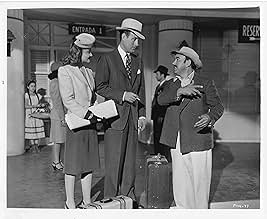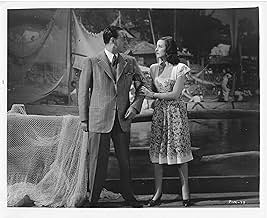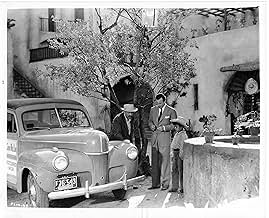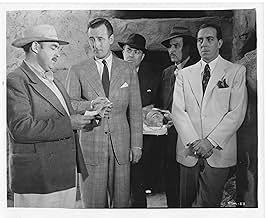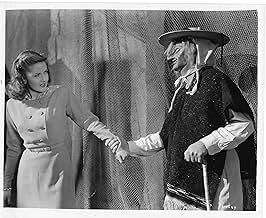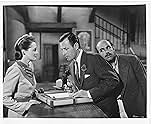Füge eine Handlung in deiner Sprache hinzuAn artist's daughter becomes suspicious when new paintings by her supposedly dead father begin turning up in New York. When a gallery owner is murdered, the Falcon and Miss Wade head for Mex... Alles lesenAn artist's daughter becomes suspicious when new paintings by her supposedly dead father begin turning up in New York. When a gallery owner is murdered, the Falcon and Miss Wade head for Mexico City to investigate.An artist's daughter becomes suspicious when new paintings by her supposedly dead father begin turning up in New York. When a gallery owner is murdered, the Falcon and Miss Wade head for Mexico City to investigate.
- Regie
- Drehbuch
- Hauptbesetzung
Martha Vickers
- Barbara Wade
- (as Martha MacVicar)
Pedro de Cordoba
- Don Carlos Ybarra
- (as Pedro De Cordoba)
Chiche Baru
- Señorita
- (Nicht genannt)
Ray Beltram
- Mexican Townsman
- (Nicht genannt)
Edward Biby
- Commuter
- (Nicht genannt)
Iris Bynam
- Maid
- (Nicht genannt)
Nina Campana
- Dueña
- (Nicht genannt)
Chester Carlisle
- Grenville
- (Nicht genannt)
Wheaton Chambers
- Jarvis
- (Nicht genannt)
Empfohlene Bewertungen
For my time, I would much rather watch an earlier Falcon film. That's because the George Sanders films were usually better written and more exciting--as well as starred the wonderful Sanders. With THE FALCON'S BROTHER, Sanders' real-life brother, Tom Conway, took over the leading role since Sanders wanted out of the series in order to pursue other acting opportunities. Now this was a very logical choice, as Conway looked a lot like Sanders and also had a similar lovely melodious voice. But despite this, I still found myself missing Sanders, as to me he was THE Falcon and the earlier films were just were written better and seemed so much fresher.
By 1944, Conway's Falcon had fallen into a rather predictable pattern that must have worked well at the time because they made so many of these films during a three year stretch--a HUGE output of 9 films! The public loved them and the series was more popular than contemporaries Boston Blackie, The Lone Wolf and Crime Doctor. So, despite my complaints, the series did work. Of course, I would contend that averaging three films a year was exactly why the films seemed not quite as good as the earlier ones--they were rushed into production and didn't seem as smooth or engaging as earlier ones.
Now THE FALCON IN Mexico is a bit better than most films of this period thanks to a relatively simple but engaging mystery. A low-point in the series was THE FALCON OUT WEST and I think most of the problem with that film was that there were too many twists and turns and surprises. Plus putting Conway out West just didn't fit his style and personality, though Mexico seemed a much better change of venues.
The plot involves the possibility that a famous dead painter MIGHT actually be alive. Either that, or the damsel in distress is losing her mind, as she keeps thinking she's seen her dead father. The Falcon, naturally, comes to her aid and by the end the mystery's all naturally been revealed.
By 1944, Conway's Falcon had fallen into a rather predictable pattern that must have worked well at the time because they made so many of these films during a three year stretch--a HUGE output of 9 films! The public loved them and the series was more popular than contemporaries Boston Blackie, The Lone Wolf and Crime Doctor. So, despite my complaints, the series did work. Of course, I would contend that averaging three films a year was exactly why the films seemed not quite as good as the earlier ones--they were rushed into production and didn't seem as smooth or engaging as earlier ones.
Now THE FALCON IN Mexico is a bit better than most films of this period thanks to a relatively simple but engaging mystery. A low-point in the series was THE FALCON OUT WEST and I think most of the problem with that film was that there were too many twists and turns and surprises. Plus putting Conway out West just didn't fit his style and personality, though Mexico seemed a much better change of venues.
The plot involves the possibility that a famous dead painter MIGHT actually be alive. Either that, or the damsel in distress is losing her mind, as she keeps thinking she's seen her dead father. The Falcon, naturally, comes to her aid and by the end the mystery's all naturally been revealed.
Something happened to the Falcon on his flight down to Mexico. He was never the same after he landed.
For the first 15 minutes or so of this movie -- set in a large U.S. city -- everything is terrific. The Falcon meets two beautiful women, commits two minor crimes, finds a corpse, gets wrongly accused of murder, escapes from custody and learns that something mysterious is going on south of the border. It doesn't all happen in exactly that order, but there's plenty of fast-paced fun.
But once the Falcon and one of the women fly to Mexico, the excitement levels off. The plot slows to a crawl. Events, including murders, seem almost random, and even the characters appear bored at time. At one point, the Falcon warns a Mexican gentleman that somebody may try to kill his daughter. The man shrugs off the tip and assures our hero that Mexico is a very safe place. He's not even curious about where the threat comes from!
The problem with the main part of this movie is that there's so much Mexico, there's no room left for mystery. There's travelogue-style footage of lakes and mountains, and some of it is very good. There are songs in Spanish, performances of masked Mexican dancers and shots of Mexican fishermen at work. There are even stereotypical "comic" Mexicans who talk like Speedy Gonzales. But there's no suspense, and the ending is very weak.
Considering when it was made, "The Falcon in Mexico" probably had a public relations component. During World War II, the U.S. government encouraged Hollywood to portray Latin America in a favorable light. But in a mystery movie, an exotic setting goes only so far. After a crackerjack start, this little whodunit is ultimately unsatisfying. It's at its weakest where it should have been strongest.
For the first 15 minutes or so of this movie -- set in a large U.S. city -- everything is terrific. The Falcon meets two beautiful women, commits two minor crimes, finds a corpse, gets wrongly accused of murder, escapes from custody and learns that something mysterious is going on south of the border. It doesn't all happen in exactly that order, but there's plenty of fast-paced fun.
But once the Falcon and one of the women fly to Mexico, the excitement levels off. The plot slows to a crawl. Events, including murders, seem almost random, and even the characters appear bored at time. At one point, the Falcon warns a Mexican gentleman that somebody may try to kill his daughter. The man shrugs off the tip and assures our hero that Mexico is a very safe place. He's not even curious about where the threat comes from!
The problem with the main part of this movie is that there's so much Mexico, there's no room left for mystery. There's travelogue-style footage of lakes and mountains, and some of it is very good. There are songs in Spanish, performances of masked Mexican dancers and shots of Mexican fishermen at work. There are even stereotypical "comic" Mexicans who talk like Speedy Gonzales. But there's no suspense, and the ending is very weak.
Considering when it was made, "The Falcon in Mexico" probably had a public relations component. During World War II, the U.S. government encouraged Hollywood to portray Latin America in a favorable light. But in a mystery movie, an exotic setting goes only so far. After a crackerjack start, this little whodunit is ultimately unsatisfying. It's at its weakest where it should have been strongest.
"The Falcon in Mexico" is a 1944 entry into "The Falcon" series, by now starring Tom Conway. In this story, Tom Lawrence (The Falcon) is in Mexico investigating the possibility that a dead artist might not be so dead after all, after he sees the model for one of the artist's portraits. The artist has been dead 15 years, but if that's the case, this woman has discovered the secret of eternal youth - until she winds up dead. Did I mention the portrait looks like a paint by numbers? Martha Vickers plays the artist's daughter, who keeps "seeing" her father. Mona Maris is her remarried stepmother who dances in a Mexican club with her new husband.
The movie is okay, with an abrupt ending, which isn't unusual in these films, and the movie seems like an ad for visiting Mexico. Supposedly some of the footage is from the Orson Welles' debacle "It's All True." If so, I'm glad RKO found good use for it.
The movie is okay, with an abrupt ending, which isn't unusual in these films, and the movie seems like an ad for visiting Mexico. Supposedly some of the footage is from the Orson Welles' debacle "It's All True." If so, I'm glad RKO found good use for it.
This "Falcon" entry relocates to Mexico and features all the stock characters and situations that one would expect from Hollywood in that setting - some of which (the repeated footage of songs in the cantina, for instance) is obviously used simply as filler. But what raises the resulting film somewhat above average is the unexpected twist it manages to place on much of its material. Barbara's exotic young stepmother turns out to be genuinely attached to her, for instance, while the grinning, thick-witted Mexican who seems to be playing a part in a bad film turns out to be a very cool bird indeed.
There is some artful photography and some smart dialogue, and while there does seem to be a certain amount of tourist advertising blatantly inserted -- literally, as in photographs of travel brochures -- this film is more interesting than I thought it was going to be. Oddly enough, while it features a number of murders they are all left more or less in the background to the main mystery, which is the question of who faked the stolen portrait... or indeed, if it was faked at all...
There is some artful photography and some smart dialogue, and while there does seem to be a certain amount of tourist advertising blatantly inserted -- literally, as in photographs of travel brochures -- this film is more interesting than I thought it was going to be. Oddly enough, while it features a number of murders they are all left more or less in the background to the main mystery, which is the question of who faked the stolen portrait... or indeed, if it was faked at all...
So is artist Wade alive or not. His daughter seems to think so even though he's supposedly ensconced in a crypt in Mexico. Fear not, however, the Falcon (Conway) is on the case. Actually the ingredients of a good mystery are present but the script mixes them up in a sloppy fashion. Much of the problem, as other reviewers note, is the big travelogue part, which only gets out of Hollywood proper thanks to some artistic Orson Welles stock footage. Otherwise it's process shots and RKO's backlot, along with that all-purpose ethnic Nestor Paiva (Manuel) furnishing a dollop of comic relief. Then too, the musical interludes tend to interrupt at inconvenient times. (Still, I really like the enchanting two little girl singers Hunter & Alvarez.)
What's worth watching for the guys, at least, are the gals, especially Vickers who's downright beautiful, at least in my book. I could have used a couple dozen more close-ups. Too bad the director treats her so casually. Anyway, the smooth-as-silk Conway is on hand to lend this slapdash programmer some class. But he really was better off with the great Val Lewton and his classic horror fests than he is here.
What's worth watching for the guys, at least, are the gals, especially Vickers who's downright beautiful, at least in my book. I could have used a couple dozen more close-ups. Too bad the director treats her so casually. Anyway, the smooth-as-silk Conway is on hand to lend this slapdash programmer some class. But he really was better off with the great Val Lewton and his classic horror fests than he is here.
Wusstest du schon
- WissenswertesSome of the Latin American exterior footage that is seen behind the opening credits, and which is inter-cut with the studio-shot scenes and projected behind the cast in some sequences, is rumored but unconfirmed to have come from Orson Welles' never-completed and Brazilian-located RKO documentary "It's All True"; that project was itself the subject of a documentary, It's All True - Orson Welles auf einer Reise durch Brasilien (1993).
- PatzerWhen Tom & Barbara fly to Mexico, they leave on a plane with AMERICAN (airlines) on the rear of the plane. When they land, they arrive on a PAN AMERICAN plane.
- VerbindungenFollowed by The Falcon in Hollywood (1944)
- SoundtracksNegrita no me dejes
(uncredited)
Music and Lyrics by Aaron González
Played on guitars by, and sung by Ruth Álvarez and Nita Hunter at the hotel
Top-Auswahl
Melde dich zum Bewerten an und greife auf die Watchlist für personalisierte Empfehlungen zu.
Details
- Erscheinungsdatum
- Herkunftsland
- Sprachen
- Auch bekannt als
- Falken i Mexico
- Drehorte
- Lake Patzcuaro, Michoacan, Mexiko("butterfly" fishing boats)
- Produktionsfirma
- Weitere beteiligte Unternehmen bei IMDbPro anzeigen
- Laufzeit
- 1 Std. 10 Min.(70 min)
- Farbe
- Seitenverhältnis
- 1.37 : 1
Zu dieser Seite beitragen
Bearbeitung vorschlagen oder fehlenden Inhalt hinzufügen

